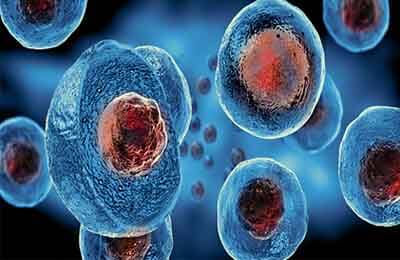Toll样受体在肿瘤中表达及促进作用的研究进展
时间:2022-07-18 04:41:45

摘要:大多数有关Toll样受体(Toll-like receptors,TLRs)的报道都是关注它们在免疫细胞的表达和功能。近来研究表明,TLRs能结合机体自身产生的一些内源性分子并对此产生反应,而且多种肿瘤细胞也表达具有多种功能活性的TLRs。现对近年TLRs及其内源性配体,TLRs信号通路,TLRs在肿瘤细胞的表达及其促进肿瘤发展进程作用的研究进展作一综述。
关键词:Toll样受体;表达;配体;信号通路;肿瘤进程
中图分类号:R730.231 Q28文献标识码:A文章编号:1672-979X(2009)01-0062-04
Progress on Expression and Promotion of TLRs in Tumor Cell
LIU Fang, XIAO Ning, LIU Lian-liang, GENG Yue*
(College of Life Science, Shandong Normal University, Jinan 250014, China)
Abstract:Most of the reports on Toll-like receptors (TLRs) have focused on their expression and function in cells of the immune system. Recent evidence shows that TLRs can link to some endogenous molecules produced by the body itself and TLRs with various functional activities are also expressed on a wide variety of tumors. This paper reviews the progress on TLRs and their endogenous ligands, TLR signaling pathways, expression of TLRs in tumor cell and their promotion on tumor progression.
Key words:Toll-like receptors; expression; ligand; signaling pathway; tumor progression
Toll受体在果蝇的胚胎发育和非特异性免疫中起关键作用。1997年在人类细胞表面发现了与Toll受体同源的分子,称为Toll样受体(Toll-like receptor,TLR)。TLRs是白介素-1受体(IL-1R)超家族的成员,在人类和小鼠中已鉴定了至少有12种TLRs。TLRs主要在细胞表面表达,但是,部分TLRs(TLR 7,TLR 8,TLR 9,某些情况下的TLR3)也可在细胞质内表达[1-3]。每种TLR通过识别相应的高度保守的病原相关分子模式(PAMPs),在介导防御外来微生物入侵的先天性免疫反应并桥连或触发适应性免疫反应中起重要作用[4,5],并且通过TLRs信号通路介导肿瘤的免疫治疗。大多数有关TLRs的报道都是关注它们在免疫细胞的表达和功能。但是近来,TLRs在肿瘤细胞的表达以及它与肿瘤发生发展的关系成了活跃的话题。
1TLRs信号通路
TLRs信号通路中TLR 1,2,5,7,8和9的信号接头分子是骨髓分化初次免疫应答效应蛋白88(MyD88)或MyD88接头样蛋白(MAL,或称为TIR相关蛋白)[3,6]。MyD88是TLRs近端唯一能转导信号的接头蛋白分子,其羧基末端有TIR区,氨基末端有死亡区(DD)[3,7]。MAL的羧基端也有TIR区,而氨基端无DD区。TLRs受体兴奋时,通过TIR-TIR的相互作用募集MyD88,然后MyD88的DD区与IL-1R相关性激酶(IRAK)结合。 MyD88-IRAK4-IRAK1复合物活化肿瘤坏死因子(TNF)受体相关因子6(TRAF6)。TRAF6是一个泛素蛋白连接酶(E3),它与泛素缀合酶(E2)形成复合物,在TRAF6自身和NEMO[IκB激酶(IKK)复合物的一个亚单位]上催化形成K63-结合的多聚泛素链。这个过程可募集转化生长因子(TGF)-β-活化激酶1(TAK1)及其结合蛋白(TAB1,TAB2和TAB33),从而引起IKK-β和丝裂原活化蛋白激酶(MAPK)6磷酸化,并活化NF-κB和MAP激酶通路以产生炎症因子[3,7]。最近研究表明,MyD88也能与IRF5和IRF7作用诱导促炎症细胞因子或Ⅰ型IFN(IFN-α和IFN-β)反应[8,9]。 TLR4信号通路既可能是MyD88-依赖性的也可能是能诱导IFN-β接头分子(TRIF)-依赖性的,TLR3信号是TRIF-依赖性的,TRIF含TIR区域[3,6]。TLR3活化引起受体相互作用蛋白1(RIP1),TRAF3和TRAF6募集,从而活化TRAF家族成员相关的NF-κB激活剂结合激酶1(TBK1)和(或)诱导IκB激酶(IKK-i),它们直接磷酸化IRF3和IRF7,产生Ⅰ型IFN细胞因子[10]。
2TLRs在肿瘤细胞的表达
研究表明,肿瘤细胞表达TLRs,并且TLRs信号有助于肿瘤的免疫逃逸和发展。Huang等[11]用RT-PCR筛选了不同组织来源的鼠源肿瘤细胞株中TLRs(包括TLR1-6和-9)的表达,包括MC26(肠癌),4T1(乳腺癌),RM1(前列腺癌),B16(黑色素瘤),LLC1(肺癌),这些肿瘤细胞系都表达多种TLRs。一些有关人胃癌细胞[12]、前列腺癌细胞[13]等的报道也有类似结果。肿瘤细胞普遍表达TLRs提示TLRs信号在肿瘤发展中可能起重要作用。
3肿瘤细胞TLRs的内源性配体
TLRs能识别来自细菌、真菌和病毒等微生物的PAMPs。利用微生物源性TLRs配体的研究表明,肿瘤细胞表达的TLRs具有功能活性[11]。但是,在肿瘤微环境中有什么样的TLRs内源性配体尚不很清楚。
用TLR4突变小鼠和TLR2基因敲除小鼠的研究表明,热休克蛋白HSP60,HSP70和HSP90的功能是通过依赖TLR4-或TLR2-途径实现的。所以,推定HSP60,HSP70和HSP90是TLR4和TLR2的内源性配体[14,15]。除HSP外,其他可能是TLRs内源性配体的分子包括纤维蛋白原[16]、硫酸肝素[17],可溶性透明质酸[18]等。
细胞凋亡是使损伤修复失败的组织重构和细胞移除所必需,由很多与炎症信号通路相同的途径严格调控。肿瘤发生细胞凋亡和坏死都释放如HMGB1和HSPs 等蛋白,它们是TLR2和TLR4配体。有学者提出染色质和DNA免疫复合物是TLR9的内源性配体[19,20],mRNA可能是TLR3的内源性配体[21]。肿瘤TLRs内源性配体的鉴定有助于进一步解释肿瘤细胞生长和逃逸宿主防御系统的机制。
4TLRs促进肿瘤进程
4.1肿瘤免疫逃逸
Huang等[11]用TLR4配体LPS刺激小鼠结肠癌细胞(MC26),发现MC26具有炎症细胞的特征,能产生促炎症性因子NO、IL-6和IL-12,这些因子使MC26抵抗细胞毒性T淋巴细胞(CTL)和自然杀伤细胞(NK细胞)的攻击并从免疫监视中逃逸。用TLR4 siRNA或细胞渗透性TLR4抑制肽干扰TLR4的表达阻滞了肿瘤生长,并因此延长了荷瘤小鼠的生存率,表明LPS的作用是通过TLR4信号实现的。Listeria monocytogenes感染H22细胞能通过TLR2信号通路引起H22细胞产生免疫抑制分子NO和IL-6[22],促进肿瘤免疫逃逸。
4.2促增殖和抗凋亡
在具有功能性TLR-MyD88通路的卵巢癌细胞(Ⅰ型EOC细胞)中,用LPS或紫杉醇活化TLR4信号,增加了细胞存活的两个重要调节子XIAP(caspase-3和-9的主要抑制子)和磷酸化AKT的表达,促进了卵巢癌细胞生长和药物抗性。在不表达MyD88的Ⅱ型EOC细胞中没有看到此反应[23]。在肺癌细胞中TLR2信号激活诱导了丝裂原活化蛋白激酶(MAPK)及NF-κB活化,它们能延长肿瘤细胞的存活[22]。
细胞凋亡或程序性细胞死亡是大多数抗肿瘤治疗包括化疗、放疗和免疫疗法的关键机制[24]。坏死或凋亡细胞释放的某些分子被认为是TLRs的配体[25],可通过TLRs刺激肿瘤细胞对死亡细胞产生类似不需微生物的炎症(“sterile”炎症反应)[26]的反应。所以,肿瘤细胞含有功能性TLR-MyD88通路时,如Ⅰ型EOC细胞,这些分子的存在能起始NF-κB活化的信号,形成产生抗细胞凋亡和促生长的微环境。
4.3增强侵袭性
高侵袭性MDA-MB-231乳腺癌细胞株表达TLR9,它一旦活化则通过增加基质金属蛋白酶13(MMP13)活性促进MDA-MB-231细胞的侵袭[27]。脂多糖通过NF-κB通路上调iNOS、MMP2和β1整合素亚体促进肿瘤的侵袭力[28,29]。TLR9调节剂能通过增加MMP13的活性来增强前列腺癌的侵袭力[13]。
5结语
肿瘤细胞普遍表达TLRs,在肿瘤发生发展中TLRs信号有重要作用。激活肿瘤细胞TLRs不仅可促进肿瘤细胞增殖和抵抗凋亡,而且可通过调节金属蛋白酶和整合素增强肿瘤细胞的侵袭和转移。此外,激活肿瘤细胞的TLRs可诱导促炎性因子和免疫抑制分子合成,它们可增强肿瘤细胞对细胞毒性淋巴细胞攻击的抵抗性并导致免疫逃逸。更好地阐释肿瘤细胞中TLRs信号通路和调控功能可产生癌症形成和发展的新观点,也能为更有效的治疗癌症提供新靶点。
参考文献
[1]Jurk M, Heil F, Vollmer J, et al. Human TLR7 or TLR8 independently confer responsiveness to the antiviral compound R-848[J]. Nat Immunol, 2002, 3(6): 499.
[2]Hemmi H, Kaisho T, Takeuchi O, et al. Small anti-viral compounds activate immune cells via the TLR7 MyD88-dependent signaling pathway[J]. Nat Immunol, 2002, 3(2): 196-200.
[3]Akira S, Takeda K. Toll-like receptor signalling[J]. Nat Rev Immunol, 2004, 4(7): 499-511.
[4]Takeda K, Kaisho T, Akira S. Toll-like receptors[J]. Annu Rev Immunol, 2003, 21(13): 335-376.
[5]Medzhitov R, Preston-Hurlburt P, Janeway Jr CA. A human homologue of the Drosophila Toll proteins signals activation of adaptive immunity[J]. Nature, 1997, 388(6640): 394-397.
[6]Takeda K, Akira S. Toll-like receptors in innate immunity[J]. Int Immunol, 2005, 17(1): 1-14.
[7]Kopp E, Medzhitov R. Recognition of microbial infection by Toll-like receptors[J]. Trends Immunol, 2003, 15(4): 396-401.
[8]Honda K, Ohba Y, Yanai H, et al. Spatiotemporal regulation of MyD88-IRF-7 signalling for robust type-I interferon induction[J]. Nature, 2005, 434 (7036): 1035-1040.
[9]Takaoka A, Yanai H, Kondo S, et al. Integral role of IRF-5 in the gene induction programme activated by Toll-like receptors[J]. Nature, 2005, 434(7030): 243-249.
[10] Akira S, Uematsu S, Takeuchi O. Pathogen recognition and innate immunity[J]. Cell, 2006, 124(4): 783-801.
[11] Huang B, Zhao J, Li H, et al. Toll-like receptors on tumor cells facilitate evasion of immune surveillance[J]. Cancer Res, 2005, 65(12): 5009-5014.
[12] Schmausser B, Andrulis M, Endrich S, et al. Toll-like receptors TLR4, TLR5 and TLR9 on gastric carcinoma cells: an implication for interaction with Helicobacter pylori[J]. Int J Med Microbiol, 2005, 295(3): 179-185.
[13] Ilvesaro J M, Merrell M A, Swain T M, et al. Toll like receptor-9 agonists stimulate prostate cancer invasion in vitro[J]. Prostate, 2007, 67(7): 774-781.
[14] Tsan M F, Gao B. Endogenous ligands of Toll-like receptors[J]. J Leukoc Biol, 2004, 76(3): 514-519.
[15] Rifkin I R, Leaderbetter E A, Busconi L, et al. Toll-like receptors, endogenous ligands, and systemic autoimmune disease[J]. Immunol Rev, 2005, 204(1): 27-42.
[16] Smiley S T, King J A, Hancock W W. Fibrinogen stimulates macrophage chemokine secretion through Toll-like receptor 4[J]. J Immunol, 2001, 167(5): 2887-2894.
[17] Johnson G B, Brunn G J, Kodaira Y, et al. Receptor-mediated monitoring of tissue well-being via detection of soluble heparan sulfate by Toll-like receptor 4[J]. J Immunol, 2002, 168(10): 5233-5239.
[18] Termeer C, Benedix F, Sleeman J, et al. Oligosaccharides of hyaluronan activate dendritic cells via Toll-like receptor 4[J]. J Exp Med, 2002, 195(1): 99-111.
[19] Boule M W, Broughton C, Mackay F, et al. Toll-like receptor 9-dependent and -independent dendritic cell activation by chromatin-immunoglobulin G complexes[J]. J Exp Med, 2004, 199(12): 1631-1640.
[20] Barrat F J, Meeker T, Gregorio J, et al. Nucleic acids of mammalian origin can act as endogenous ligands for Toll-like receptors and may promote systemic lupus erythematosus[J]. J Exp Med, 2005, 202(8): 1131-1139.
[21] Kariko K, Ni H, Capodici J, et al. mRNA is an endogenous ligand for Toll-like receptor 3[J]. J Biol Chem, 2004, 279(13): 12542-12550.
[22] Huang B, Zhao J, Shen S, et al. Listeria monocytogenes promotes tumor growth via tumor cell toll-like receptor 2 signaling[J]. Cancer Res, 2007, 67(9): 4346-4352.
[23] Kelly M G, Alvero A B, Chen R, et al. TLR-4 signaling promotes tumor growth and paclitaxel chemoresistance in ovarian cancer[J]. Cancer Res, 2006, 66(7): 3859-3868.
[24] Alvero A B, O’Malley D, Brown D, et al. Molecular mechanism of phenoxodiol-induced apoptosis in ovarian carcinoma cells[J]. Cancer, 2006, 106(3): 599-608.
[25] Chen R, Alvero A B, Silasi D-A, et al. Inflammation, cancer and chemoresistance: taking advantage of the Toll-Like receptor signaling pathway[J]. Am J Reprod Immunol, 2007, 57(2): 93-107.
[26] Chen C J, Kono H, Golenbock D, et al. Identification of a key pathway required for the sterile inflammatory response triggered by dying cells[J]. Nat Med, 2007, 13(7): 851-856.
[27] Merrell M A, Ilvesaro J M, Lehtonen N, et al. Toll-like receptor 9 agonists promote cellular invasion by increasing matrix metalloproteinase activity[J]. Mol Cancer Res, 2006, 4(7): 437-447.
[28] Harmey J H, Bucana C D, Lu W, et al. Lipopolysaccharide-induced metastatic growth is associated with increased angiogenesis, vascular permeability and tumor cell invasion[J]. Int J Cancer, 2002, 101(5): 415-422.
[29] Wang J H, Manning B J, Wu Q D, et al. Endotoxin/lipopolysaccharide activates NF-kappa B and enhances tumor cell adhesion and invasion through a beta 1 integrin-dependent mechanism[J]. J Immunol, 2003, 170(2): 795-804.
